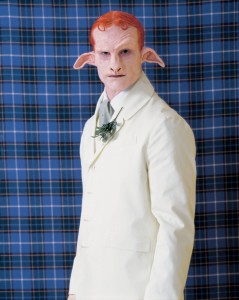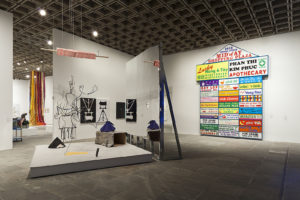
The avant-garde is dead. There is no more “cutting edge.” The Whitney Biennial, which used to bill itself as an exhibit of risky art that outraged the establishment, has dropped even that pretense. A typical artist in this year’s Biennial is a middle-aged associate professor of art who does the sort of things that used to be considered radical, but are now, well, academic.
Consider Chris Larson.
He’s in his late 40s. He teaches sculpture at the University of Minnesota. Last year he built a superficial replica of a house by the Bauhaus architect Marcel Breuer. Then, with the press in attendance, he set it on fire and burned it to the ground. Breuer, it should be noted, also designed the Whitney Museum, so Larson has a certain timeliness, especially because this will be the last Biennial held in the landmark building before the Whitney moves to a new building downtown.
Then there’s Joe Scanlan. He’s in his early 50s. He teaches sculpture at Yale. He makes wood sculptures in a cubist style and attributes them to an alter-ego – a fictional young black woman artist named Donelle Woolford. He likes the irony inherent in an artist of African descent making cubist art out of wood, because cubism was partly inspired by African wood sculpture. When journalists come to interview him, he hires a young black actress to answer the questions.
Or, consider Lisa Anne Auerbach. She’s in her late 40s and is an assistant professor of art at Pomona College in California. Auerbach produces machine-knit sweaters with radical slogans on them – creating a tension between hard-edged politics and a traditional feminine craft. For the Biennial she made a banner covered with quotes from storefront psychics. Then she printed a five-foot-tall magazine, which she calls a Megazine, featuring photographs and conversations from the oddball psychics she interviewed. Two assistants, wearing her sweaters, turn the huge pages for visitors.
These are only three out of 103 participants in this year’s Biennial, but they illustrate what has happened to contemporary art over the past several decades. Art used to originate outside the academy. There were teachers, yes, and artists went to art schools, but the schools taught mostly basic skills and left the mysteries to those who had the talent to tackle them. Artist-professors who are in their 40s and 50s today went to college in the ‘80s, by which time once-radical styles were institutionalized. You could – and can — go to CalArts and study to be a conceptual artist, an idea that would have seemed hilarious in 1965.
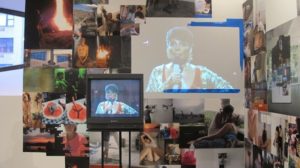
Visually, this Biennial is an absolute mess, a three-level Tower of Babel, in which galleries are crowded with things that, if they could talk, would be incomprehensible to each other – a pup tent, stuffed animals, paint-smeared flat-screen TVs, antique furniture, X-rated mannequins, and a photo display about a transgender filmmaker couple who are transitioning in opposite directions. There are headphones to put on, dark rooms to enter, and cases of arcane memorabilia to peer into.
Maximum chaos has been achieved by handing the reins over to three curators – MoMA’s Stuart Comer, ICA Philadelphia curator Anthony Elms, and Chicago-based artist and professor Michelle Grabner – each given a floor to play with.
It shouldn’t be surprising that in an art world now dominated by academic theory, the common-sense distinction between artist, curator and scholar would be blurred. Grabner, for example, wears all three hats. She is the first practicing artist to curate the event in its 80-year history. Her art, not on view here, is a dry production of black-and-white patterns that look like interwoven strips of fabric. Back home, she curates exhibits in a backyard garden shed called The Suburban.
She speaks fluent art babble: “I developed a fourth-floor curriculum that presents identifiable themes, generalities even, that are currently established in the textures of contemporary aesthetic, political, and economic realities.”
This Biennial will probably be best remembered for shows within the show. On the second floor, for example, Joseph Grigley’s artwork is a display of memorabilia about the art critic Gregory Battcock. Battcock, once the flamboyant editor of Arts Magazine, appeared in several Andy Warhol films and wrote numerous books in the ‘60s and ‘70s about “the new art.” He was murdered in Puerto Rico in 1980.
The institutionalization of conceptual art, which often substitutes words for crafted objects, has even made it possible for the late novelist David Foster Wallace to be a Biennial artist. On view are notes he left in a set of Cuddly Kittens journals while working on “The Pale King.” The novel was left unfinished when he committed suicide in 2008.
Why, even a publishing house can be an artist, here. Semiotext(e), credited with bringing – what else? – French deconstructionist theory to North America, displays a new series of single-essay pamphlets in “an installation” by L.A. artist Jason Yates.
Where would our culture be without brave artists like these?

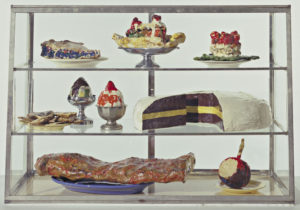
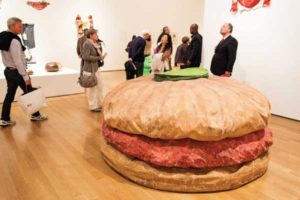

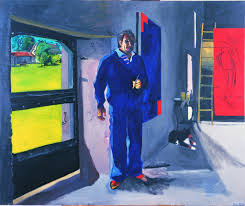
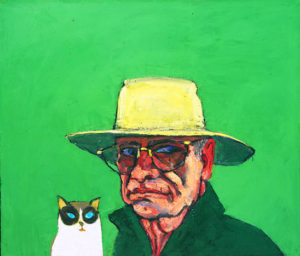

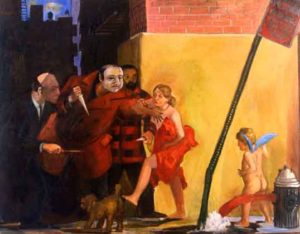
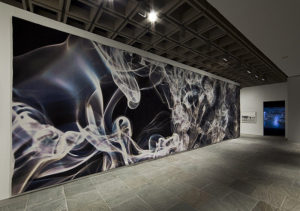




 Burton spent two years at the California Institute of the Arts (CalArts), then four years as an animator at The Walt Disney Studios. The drawings he did in his spare time show a penchant for sight gags: to illustrate a man undressing a woman with his eyes, he shows eyeballs literally jumping out of their sockets on stalks and unzipping the clothes.
Burton spent two years at the California Institute of the Arts (CalArts), then four years as an animator at The Walt Disney Studios. The drawings he did in his spare time show a penchant for sight gags: to illustrate a man undressing a woman with his eyes, he shows eyeballs literally jumping out of their sockets on stalks and unzipping the clothes.